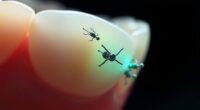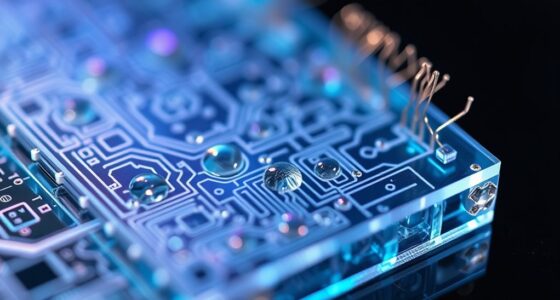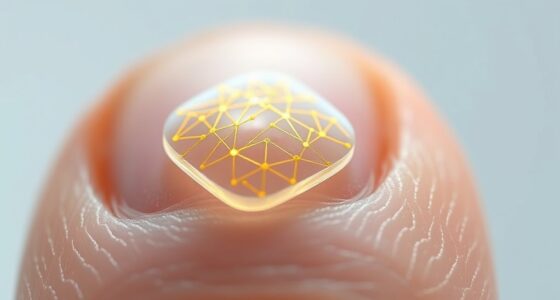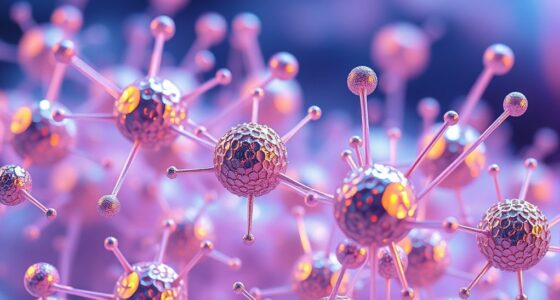Nanomachines interact with your immune system by targeting specific cells, delivering drugs, or modifying immune responses using surface modifications like antibodies and ligands. They can evade detection with PEG coatings or shape optimization, or boost immunity by stimulating immune cells directly. Researchers are designing safer, biocompatible devices to precisely activate or suppress immune pathways. If you’re curious, discovering more will show how these tiny tools are transforming immune-based therapies and disease management.
Key Takeaways
- Nanomachines can target immune cells using surface modifications like ligands and charge interactions to modulate immune responses precisely.
- They trigger immune pathways such as Toll-like receptors to activate or suppress immune functions as needed.
- Surface coatings like PEG enable nanomachines to evade immune detection, enhancing biocompatibility and reducing inflammation.
- Pathway-specific nanodevices allow targeted immune signal manipulation, improving vaccine efficacy and immune modulation strategies.
- Ethical and safety considerations include designing biodegradable, non-toxic nanomachines and addressing cybersecurity vulnerabilities.
The Basics of Nanomachines in Medicine
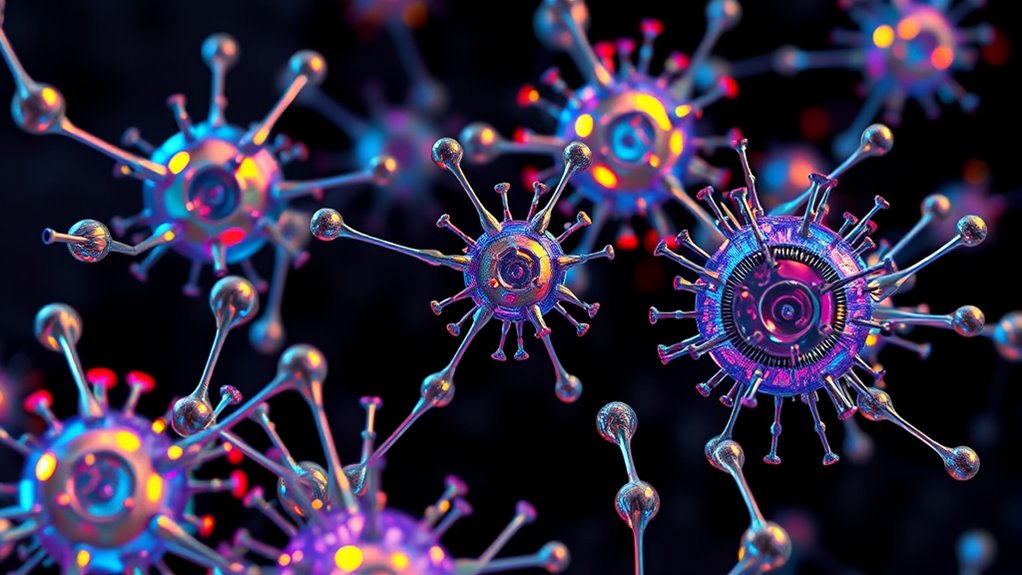
Nanomachines are tiny devices, often no larger than a few nanometers, designed to perform specific tasks within the body. They are engineered to target cells, deliver drugs, or repair tissues with high precision. Unlike traditional medicines, nanomachines can navigate biological environments at the molecular level, allowing for targeted interventions. You can think of them as microscopic robots that operate inside your body, executing complex functions that were once impossible. They’re constructed using advanced materials like DNA, proteins, or synthetic compounds, giving them flexibility and control. Researchers are developing nanomachines to diagnose diseases early, deliver medication directly to affected areas, and even perform surgical procedures at a cellular level. Their potential is transforming medicine into a highly precise, personalized science. Additionally, advancements in projector technology are paving the way for more sophisticated imaging and diagnostic tools that could complement nanomedical applications in the future.
How Nanomachines Interact With Immune Cells

You need to understand how nanomachines recognize and target immune cells through specific cellular mechanisms. Once inside, they can activate immune pathways or avoid detection altogether. Exploring these interactions reveals strategies for effective delivery and immune evasion. Additionally, understanding filtration systems can aid in designing nanomachines that effectively bypass immune defenses.
Cellular Targeting Mechanisms
Understanding how nanomachines target immune cells requires examining their surface modifications and recognition strategies. You’ll find that these tiny devices use specific mechanisms to identify and bind to immune cells effectively. First, they often display surface ligands that mimic natural cell markers, enhancing recognition. Second, nanomachines can be functionalized with antibodies tailored to unique cell surface proteins, ensuring precise targeting. Third, some use charge-based interactions, exploiting differences in cell membrane charge to localize to immune cells selectively. These strategies enable nanomachines to navigate complex biological environments and hone in on their intended immune cell targets. By leveraging surface modifications and recognition tactics, they achieve high specificity, essential for effective immune modulation without off-target effects.
Immune Activation Pathways
When nanomachines interact with immune cells, they often trigger specific activation pathways that modulate immune responses. For example, nanomachines can activate pattern recognition receptors like Toll-like receptors (TLRs), initiating signaling cascades that lead to cytokine production. This activation can stimulate immune cells such as macrophages and dendritic cells, enhancing their ability to present antigens and produce inflammatory mediators. Additionally, nanomachines may influence the NF-κB pathway, a key regulator of immune gene expression, resulting in heightened immune activity. Understanding these activation pathways is vital for engineering nanomachines that effectively interact with immune cells without causing unintended inflammation. Furthermore, cybersecurity vulnerabilities during the development or deployment of nanomachines could pose risks to data integrity and safety, emphasizing the need for secure design practices.
Evasion Strategies Explored
Nanomachines designed to interact with immune cells must navigate the body’s defense mechanisms, which have evolved sophisticated methods to detect and eliminate foreign entities. To evade these defenses, you might employ several strategies:
- Camouflage: Coating nanomachines with cell membrane fragments or biomimetic materials makes them appear native, reducing immune recognition.
- Immune Suppression: Releasing molecules that temporarily dampen immune responses can prevent activation and clearance.
- Size and Shape Optimization: Designing nanomachines with specific dimensions minimizes detection by immune cells, allowing smoother passage through tissues.
- Understanding Immune Evasionis crucial for advancing nanomedicine to develop more effective stealth strategies and improve biocompatibility.
Strategies for Immune Evasion by Nanodevices

To successfully avoid detection by the immune system, nanodevices employ a range of sophisticated strategies that minimize their biological footprint. One common approach is surface modification, such as coating nanodevices with biocompatible materials like polyethylene glycol (PEG), which creates a “stealth” layer that prevents immune recognition. Another tactic involves mimicking natural biological molecules, allowing nanodevices to blend seamlessly with surrounding tissues and evade immune sensors. Controlling size and shape also plays a role; smaller or uniquely shaped nanodevices are less likely to trigger immune responses. Additionally, some designs incorporate dynamic surface properties, enabling nanodevices to alter their appearance in real-time, further reducing their detectability. These strategies collectively enhance the nanodevices’ ability to operate undetected within biological environments, and ongoing research aims to refine these techniques for improved immune evasion capabilities.
Enhancing Immune Responses With Nanotechnology
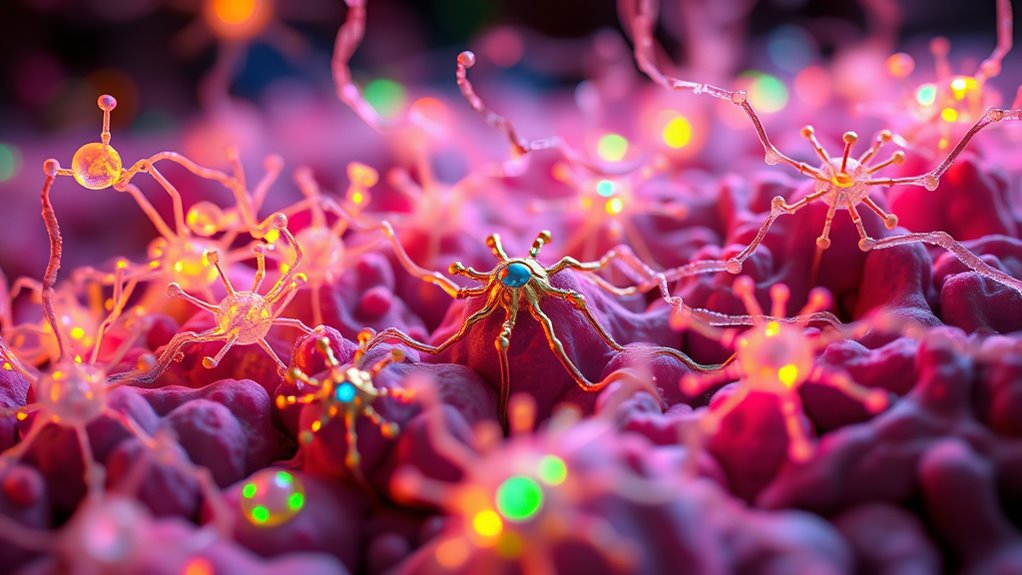
Advancements in nanotechnology have opened new avenues for actively boosting the immune system’s ability to detect and combat pathogens. You can leverage nanomaterials to improve vaccine efficacy, enhance immune cell activation, and deliver immunostimulatory agents more precisely. Here are three ways nanotechnology amplifies immune responses:
- Nanoparticle-based vaccines: Increase antigen stability and targeted delivery, leading to stronger immune activation.
- Immune cell priming: Nanodevices can directly stimulate dendritic cells or macrophages, boosting their ability to present antigens.
- Adjuvant delivery: Nanocarriers efficiently transport adjuvants to immune sites, amplifying the body’s natural response.
Targeting Specific Immune Pathways Using Nanomachines
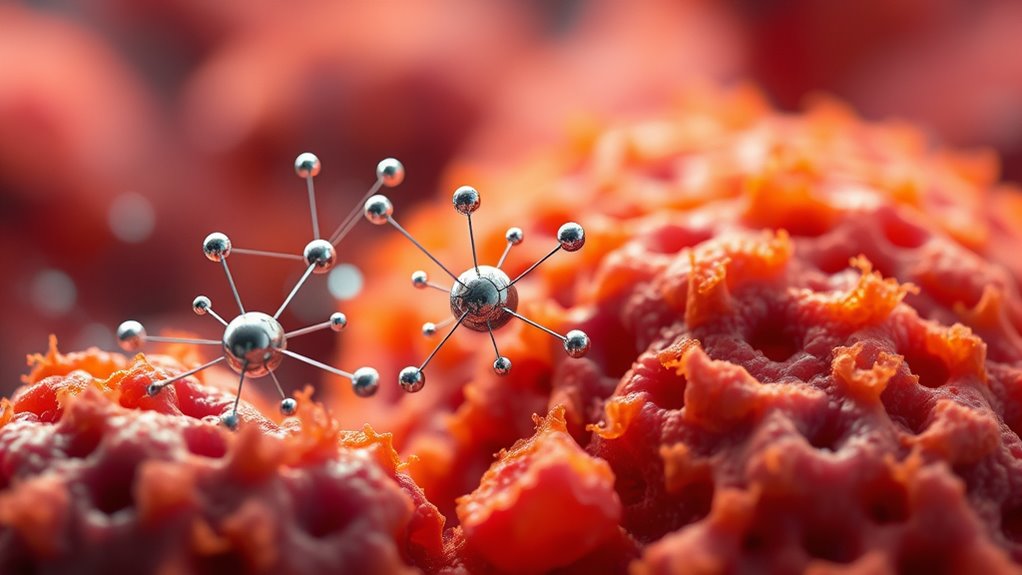
You can harness nanomachines to precisely modulate immune pathways, enhancing treatment accuracy. Pathway-specific nanodevices enable you to target only the relevant immune signals, reducing side effects. This approach offers a new level of control in immune therapy, making treatments more effective and personalized. Understanding immune signaling is crucial for developing precise nanomachine interventions.
Precision Immune Modulation
Nanomachines are revolutionizing immune modulation by precisely targeting specific immune pathways, allowing for more effective and tailored treatments. This precision enables you to fine-tune immune responses, reducing side effects and increasing efficacy. Here’s how they make a difference:
- Selective targeting: Nanomachines deliver drugs directly to immune cells or pathways, minimizing off-target effects.
- Controlled release: They release therapeutic agents in response to specific signals, ensuring timing and dosage are ideal.
- Pathway modulation: These devices can amplify or suppress particular immune signals, restoring balance in autoimmune or inflammatory conditions.
Pathway-Specific Nanodevices
By targeting specific immune pathways, pathway-specific nanodevices enable precise modulation of immune responses, minimizing unintended effects. These nanodevices are engineered to recognize and interact with particular molecules or receptors involved in immune signaling, allowing you to direct treatment exactly where needed. For example, you can design nanomachines to target T-cell activation pathways or cytokine production pathways, effectively enhancing or suppressing specific immune functions. This targeted approach reduces side effects common with broad-spectrum therapies. You can also customize nanodevices to respond to environmental cues or disease-specific markers, ensuring they act only in relevant contexts. Additionally, advancements in educational toys have contributed to understanding how to design complex systems like nanodevices for targeted therapeutic applications. As a result, pathway-specific nanodevices offer a refined tool to fine-tune immune responses, improving therapeutic outcomes while limiting collateral damage.
Challenges in Balancing Immune Activation and Suppression
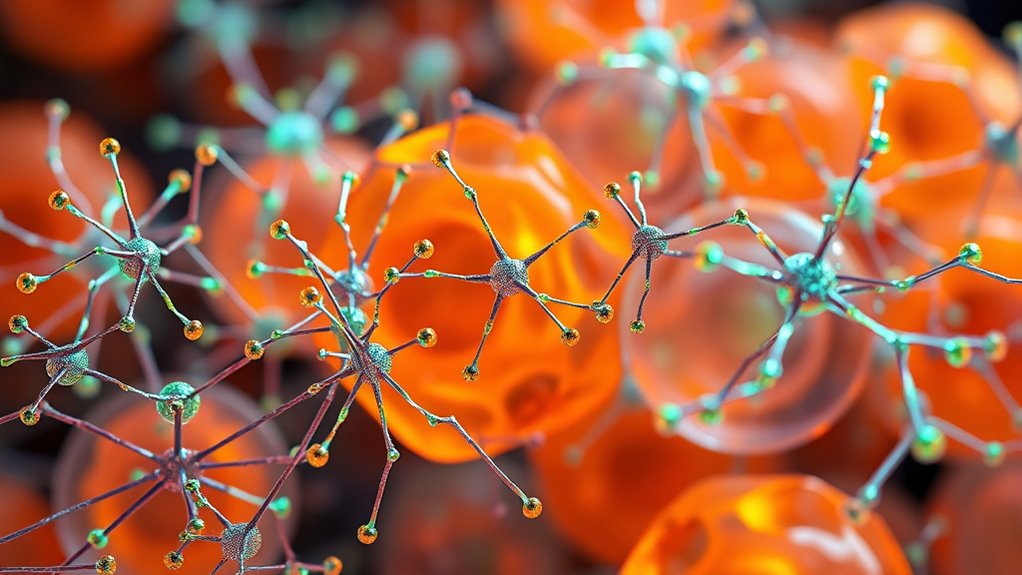
Balancing immune activation and suppression remains a significant challenge because altering one aspect can unintentionally weaken the body’s ability to fight infections or promote harmful inflammation. You need to carefully control nanomachine interactions to avoid tipping the scale. Consider these hurdles:
Balancing immune modulation is complex; precise nanomachine control is essential to avoid harmful effects.
- Ensuring targeted activation without triggering systemic inflammation.
- Preventing over-suppression that leaves the body vulnerable to pathogens.
- Achieving precise modulation over time, so immune responses adapt without overshooting.
- AI security concerns highlight the importance of safeguarding nanomachines from malicious interference, ensuring their safe and effective operation.
Navigating these issues requires a nuanced approach, as even small miscalculations can lead to adverse effects. You must develop nanomachines that can fine-tune immune responses dynamically, maintaining health without causing unintended consequences. This delicate balance is essential for effective immune modulation strategies.
Designing Biocompatible and Safe Nanomachines
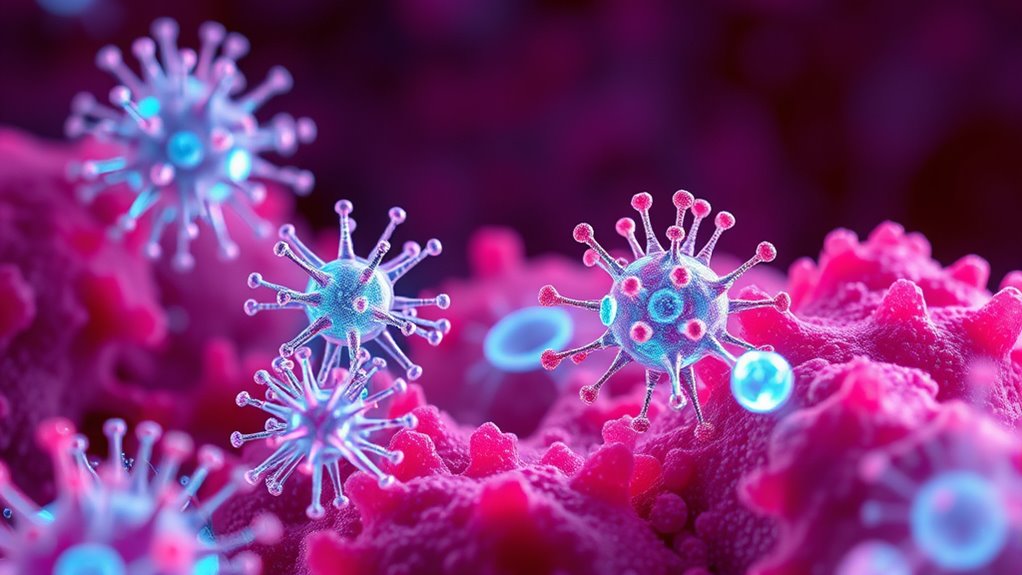
Designing nanomachines that are both biocompatible and safe is essential to prevent adverse reactions within the body. You should choose materials that are non-toxic and minimize immune recognition, such as biodegradable polymers or inert metals. Surface modification techniques, like PEGylation, can help evade immune detection and reduce inflammation. Ensuring your nanomachines are stable under physiological conditions prevents unintended degradation or release of harmful substances. You must also consider size and shape, as these factors influence immune response and biodistribution. Incorporating targeting ligands can improve specificity, reducing off-target effects. Testing in vitro and in vivo is vital to assess biocompatibility, immunogenicity, and safety profiles. Additionally, understanding immune system interactions is crucial for designing nanomachines that do not trigger adverse immune responses. Ultimately, careful design and thorough evaluation help create nanomachines that work effectively without compromising the body’s immune balance.
Future Directions in Nanomachine-Immune System Research
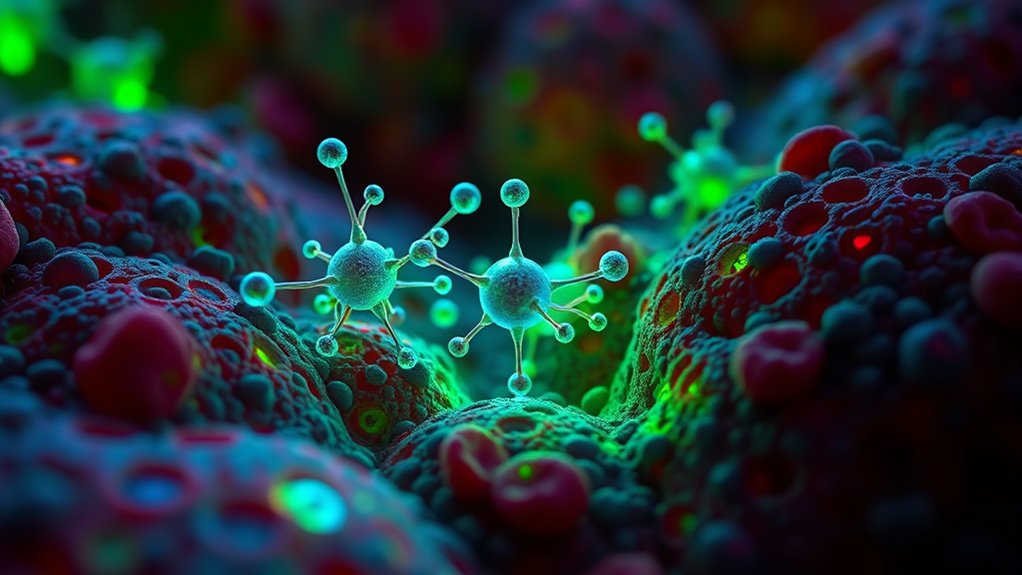
Advances in nanotechnology and immunology are opening new avenues for developing smarter, more adaptive nanomachines that can seamlessly interact with the immune system. To shape this future, focus on:
- Enhancing targeting precision to reduce side effects and improve treatment efficacy.
- Developing real-time sensing capabilities for dynamic immune responses.
- Creating bio-inspired designs that mimic natural immune processes for better integration.
- Integrating paint sprayer technology insights to improve delivery mechanisms and coating precision in nanomachine applications.
Ethical and Regulatory Considerations in Nanomedicine

As nanomedicine progresses, addressing ethical and regulatory considerations becomes crucial to guarantee responsible development and deployment. You need to understand the potential risks, such as unforeseen side effects or long-term impacts on health and the environment. Regulations should keep pace with innovation, ensuring safety without stifling progress. Transparency and public engagement are essential, so you can trust the science and its applications. You also have to contemplate issues like privacy, consent, and equitable access, especially as nanomachines could alter immune responses or target specific populations. Establishing clear guidelines helps prevent misuse and ensures that nanomedicine benefits society while minimizing harm. Ultimately, your awareness and adherence to ethical standards foster trust and support sustainable advancements in this rapidly evolving field.
Frequently Asked Questions
How Do Nanomachines Differentiate Between Healthy and Infected Cells?
You can program nanomachines to differentiate between healthy and infected cells by recognizing specific markers or signals unique to infected cells, such as altered surface proteins or chemical signatures. These nanomachines use sensors to detect these markers, then activate targeted responses like releasing medication or destroying the infected cells. This selective detection guarantees they act precisely, minimizing damage to healthy cells and improving treatment effectiveness.
What Long-Term Effects Might Nanomachines Have on Immune System Memory?
Long-term, nanomachines could enhance your immune system’s memory by precisely targeting and training immune cells, making future responses faster and stronger. However, there’s a risk they might overstimulate or weaken your immune memory if not carefully controlled. You might experience increased resistance to infections, but also potential immune dysregulation. Ongoing research aims to balance these effects, ensuring nanomachines support your immune health without unintended consequences over time.
Can Nanomachines Inadvertently Trigger Autoimmune Responses?
Nanomachines can unintentionally set off autoimmune responses, like a false alarm ringing through your immune system. If they’re recognized as foreign or trigger unintended immune pathways, your body might attack its own tissues. While advances aim to minimize this risk, it’s essential to carefully design and regulate nanomachines to prevent them from becoming unwelcome troublemakers, ensuring your immune system stays balanced and doesn’t turn against you.
How Do Nanomachines Handle Rapid Immune System Changes During Infections?
Nanomachines adapt to rapid immune system changes by sensing shifts in immune signals and adjusting their functions accordingly. They can detect inflammation markers, modulate their activity, and even release targeted treatments to support the immune response. This dynamic interaction helps them stay effective during infections, ensuring they don’t interfere with natural defenses while providing precise intervention when needed. Your nanomachines consequently work in harmony with your immune system’s rapid changes.
Are There Risks of Nanomachines Causing Immune System Fatigue or Suppression?
Think of nanomachines as tiny guardians patrolling your immune fortress. While they’re designed to assist, there’s a risk they might overstay their welcome, causing fatigue or suppression if they interfere with natural defenses. You need careful control to prevent them from overwhelming your immune system, much like a vigilant guard who’s too aggressive. Proper modulation ensures they support your immunity without draining or weakening your body’s defenses.
Conclusion
You should know that nearly 60% of emerging nanomedicine trials focus on immune system interactions. This highlights how essential nanomachines are becoming in immunotherapy and disease management. As research advances, you’ll see more targeted therapies and safer designs, but ethical considerations remain critical. Staying informed about these developments will help you understand how nanomachines could revolutionize medicine and improve patient outcomes in the near future.

